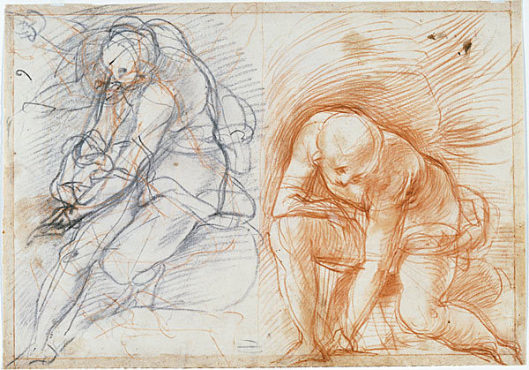Every drawing you do has the potential to suck. Or not.
The fear of making mistakes is what keeps many of us from even trying to draw. However, it is possible to embrace failure and actually enjoy salvaging a drawing from the brink of disaster. Sketching through your mistakes on paper is an important and fun part of learning to draw accurately.

Check out how Renaissance artist, Jacopo Pontormo (1494–1557), used multiple lines to correct contours forming the figures in his study sketch (shown above). Can you find where he struggled to correct mistakes in arm measurements on the figures?
No great drawing artist has ever escaped the frustration of making mistakes. Vincent Van Gogh (1853–1890), who was mostly self-taught and sketched incessantly, wrote, “Even the knowledge of my own fallibility cannot keep me from making mistakes. Only when I fall do I get up again.” If you are learning to draw from observation, you’ve already come to know your fair share of work that just doesn’t look right. Taking time to spot errors and correcting them are key skills in making realistic drawings.
We’ve grown up thinking that beautiful drawings come easily and magically to those who create them. We tend to think each line in a picture is perfectly drawn by the artist without any struggle. Truth is, behind most wonderful artworks are countless hours spent making preliminary sketches, correcting proportions, redrawing contour edges, and adjusting tonal values. Even the Renaissance artist Michelangelo (1475–1564) was plagued by challenges and mistakes: “If people knew how hard I worked to get my mastery, it wouldn’t seem so wonderful at all.”
So, where does that leave us mere mortals who simply want to draw a bowl of fruit accurately enough that we can show it to family and friends? When it comes down to it, if we want to find ways to improve our skills in observational drawing and correcting mistakes, we need a solid practice routine.
Here are 7 tips on how to enjoy making and correcting drawings:
1. Choose things you enjoy drawing: YOU have the power to have fun learning to draw. Draw things that fascinate you. Flowers in your yard, your family pet sleeping on the sofa—there’s a world of subject matter to choose from. If the inspiration of the moment is a kitchen spatula sitting on a table; then grab your sketchbook, spend five minutes, and sketch it.
2. Make stacks of study sketches (and save them!): If time permits, warm up by doing several quick studies of your subject. Your brain will start recording huge amounts of visual information even before you get into more complex aspects of measuring. It’s fun to look back on earlier failures to see how much you’ve improved. Pontormo’s figure sketch shows the artist’s mistakes and thinking process on the paper.
3. Draw lightly: Get sketchy! I’m always reminding students to draw lightly and keep their work loose and open for as long as possible. This enables you to make changes spontaneously without having to erase. You can commit to darker lines once you’ve established correct measurements.
4. Put the erasers away!: Really. Hide them, right now. Use artist pencils without erasers on the end. Show your thinking process on the paper. Force yourself to sketch over and through mistakes without erasing. Erasers are an important tool in drawing, but not when learning basic observational skills. My students have to get a good sketching rhythm going before “graduating” to an eraser. By then they usually have forgotten about needing them.
5. Simplify: Lightly block in three or four basic shapes of your subject matter, even if it’s a complex still life or landscape. Take time to measure and compare relationships between the shapes. Make necessary changes and, if needed, make additional sketches before moving to a more detailed, finished drawing. These basic shapes will serve as the foundation for an accurate drawing. Remember: keep it sketchy and light until you get it right.
6. Study the work of others: It’s important to look at the line work in sketches and drawings by master artists such as Leonardo, Degas, Rembrandt, or Rubens. But you’ll also learn valuable lessons by looking at corrections and refinements on the pages in any artist’s sketchbook—amateur or professional. Sharing sketchbooks is also a great way to spend a social evening.
7. Carry your sketchbook with you: Draw anything and everything that looks fun and interesting to draw. Do this every chance you get. Travel with a sketchbook. Eat lunch with a sketchbook. FAIL in a sketchbook. I guarantee it will improve your skills and confidence in a big way.
Another famous sketcher and inventor, Thomas Edison (1847–1931), drew often in his notebooks to capture ideas and solve problems. Among his many popular quotes on failure is this one: “I have not failed. I’ve just found 10,000 ways that won’t work.” Lucky for us, we don’t have to sketch that bowl of fruit 10,000 times to improve our drawing. Instead, by making just a few honest, failed attempts we will become more accurate observers as we enjoy learning to draw from life.
Rob Court
Latest posts by Rob Court (see all)
- Drawing With Friends - April 11, 2022
- Frozen in Time: Cellphone Users as Models to Draw - April 8, 2022
- Getting Out & Getting Real - June 20, 2021
- Life Lines: Sketching the Unseen World of Movement - June 20, 2021
- The Ups & Downs of Urban Sketching - May 9, 2021